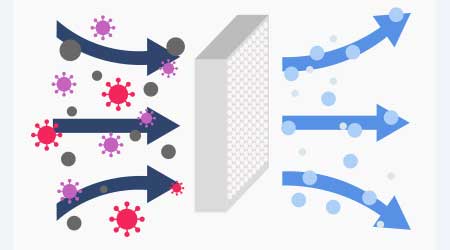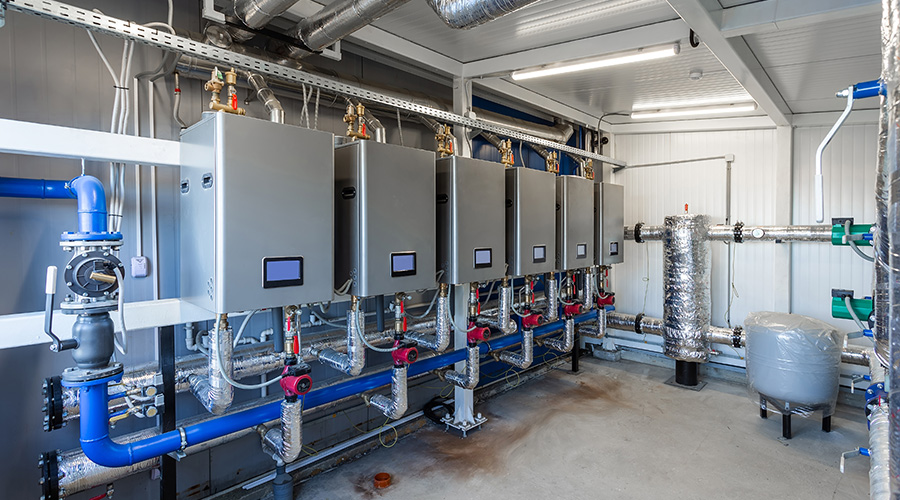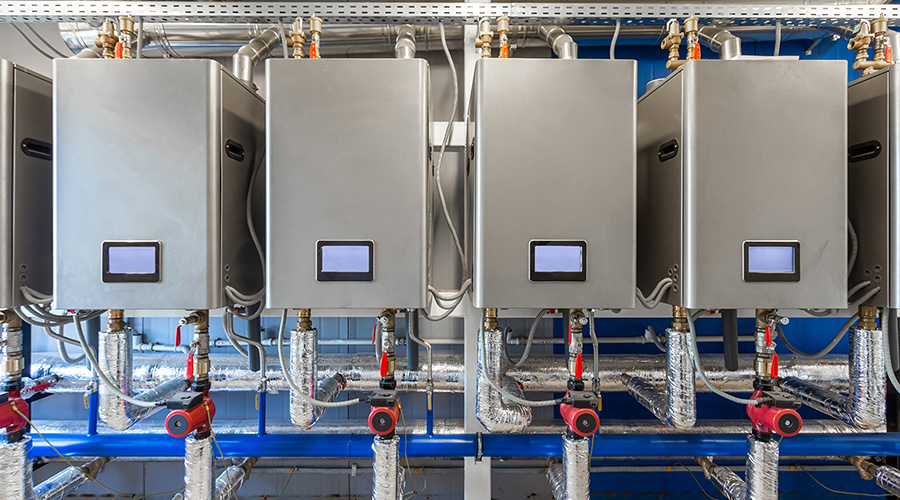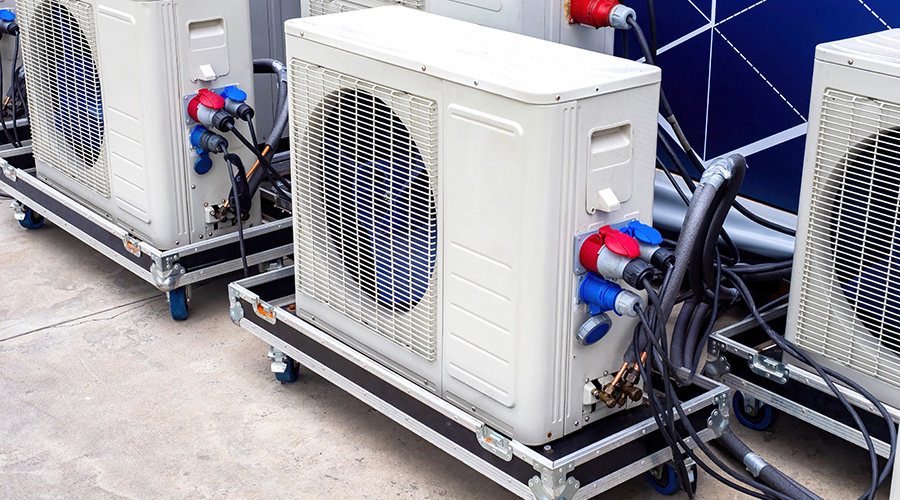4 Effective Air Filtration System Options
The COVID-19 pandemic has focused attention on new technologies designed to provide cleaner air in all types of facilities.
Good indoor air quality in buildings depends to a great extent on the effectiveness of the HVAC air filtration system. Originally designed primarily to keep heating and cooling coils free of dust and dirt accumulation, these systems have evolved to keep up with the changing needs of the building occupants.
Where dust and dirt were once the only target of these systems, concerns over gaseous, chemical, biological, and radiological contaminants have resulted in new demands being placed on air filtration systems. The pandemic has further focused attention on the need for clean, conditioned air.
To meet this need, manufacturers have made changes to existing filtration systems that improve their performance. New technologies have evolved that can be used to effectively reduce or eliminate different types of contaminants. The result is that managers today have options. To make the best use of these options, facility managers must first understand the types of airborne contaminants found in their facilities and what systems work best to remove those contaminants.
There are three general classes of contaminants found in building HVAC systems: particulate, gaseous, and biological. Each requires a tailored system design in order to reduce their concentration in HVAC systems.
The most common types of filters in HVAC systems are designed to reduce the concentration of particulate contaminants originating from within the building or from air drawn into the building from the outside. These contaminants include dust, dirt, smoke, and mists. They typically range in size from 0.01 microns for smoke to several thousand microns for dirt.
Gaseous contaminants include ozone, nitrogen oxide, nitrogen dioxide, carbon monoxide, and sulfur dioxide. While some are the result of off-gassing from synthetic materials found within the building, such as caret, adhesives, and composite materials, most are introduced into the building from outside sources through the HVAC system’s fresh air intake. Gaseous contaminants typically are less than 0.01 micron in diameter.
Biological contaminants include bacteria, viruses, and fungal organisms. They can come from within the building or can be drawn into the building through the HVAC system’s fresh air intake. Biological contaminants are a fraction of the size of other contaminants.
1. Mechanical air filters
The most widely used filtration system in building HVAC systems is the mechanical air filter. The filters consist of spun glass or a high-loft, non-woven material that operate through the process of straining and impaction of particles with the filter material. The rate at which the filter media removes particles from the air passing through it is the filter’s efficiency.
Filters from different manufacturers have different efficiencies, depending on the design and construction of the filter. Fortunately, ASHRAE has developed a standard for testing the efficiency of filters, Standard 52.2, “Method of Testing General Ventilation Air-Cleaning Devices for Removal Efficiency by Particle Size.” Filter designs that are tested using the standard are given a rating number called the minimum efficiency reporting value (MERV).
The higher the MERV rating, the better the filtration. For example, a filter with a MERV rating of between 5 and 8 will remove 80 to 95 percent of the particles in the airflow that are three microns or larger. One with a MERV rating between 9 and 12 will remove 90 percent or more of the particles one micron or larger. Filters with a MERV rating greater than 13 can remove 95 percent or more of the particles 0.3 microns or larger.
Higher filtration efficiencies are available through the use of high efficiency particulate air filters (HEPA). These filters can capture up to 99.7 percent of all contaminants 0.3 microns or greater.
While a higher MERV rating means a greater filtration efficiency, it also means there will be a greater resistance to airflow in the system. This resistance must be made up through increased fan energy use. Therefore managers must balance the need to remove particles of a certain size against the ability of the HVAC system to provide the necessary airflow to the occupied space.
Mechanical filters come in a number of different designs based on the needs of the application. The most commonly used design is the flat panel. Flat panel filters operate through the process of straining. Particles in the airflow impact the filter media and become trapped. Most flat panel filters have a MERV rating of five or less, making them suitable for use in applications where the HVAC system is not exposed to a very dirty environment. Their primary advantage is their low cost.
Some flat panel filters make use of a pleated filtering material to provide a larger filtering surface. More expensive than a true flat panel filter, pleated filters typically have a MERV rating between 5 and 8. This makes them suitable for use in a wide range of commercial and institutional applications where their higher cost can be justified by their ability to provide a cleaner airflow.
In applications where there is a need for higher filtration efficiencies without significantly increasing the pressure drop across the filter, bag filters can be used. Bag filters offer a MERV rating between 11 and 15. They offer the advantage of providing a large filtering surface without having to increase the cross section of the HVAC duct, although they do require a longer section of duct. Most have a MERV rating between 6 and 11. Bag filters are significantly more expensive than flat panel or pleated filters.
2. Gas-phase systems
Mechanical air filters, while effective in removing particulate contaminants from the HVAC system, cannot remove all contaminants. For example, gaseous contaminants are not impacted by mechanical air filters. While HEPA filters are effective in removing particles in the 0.3 micron range, gases and vapors are 0.01 microns or less. Removing them from the airstream requires the installation of a gas-phase air cleaner.
Gas-phase systems work on the principle of adsorption, the process whereby atoms or molecules of a gas, liquid, or dissolved solid become chemically attached to a surface. The most commonly used material in gas-phase systems is activated charcoal.
The systems can effectively remove chemical vapors, volatile organic compounds, ozone, and almost any vapor. Applications include facilities where vapors, fumes, or chemicals are routinely released into the air within the occupied space. They also may be installed in facilities where the HVAC fresh air intake is located near a source of pollution, such as a loading dock.
Gas-phase systems are typically installed with the HVAC system’s duct. Standalone units are available that can treat the air in a particular area. A pre-filter is installed in front of the adsorption filter to prevent solid particulates from clogging the unit.
3. UV light systems
Neither mechanical air filters or gas-phase filters are effective against biological contaminants as the biological particles simply are too small. But UV light of the proper wavelength and in high enough doses is effective in killing or deactivating many biological contaminants.
UV light has been used for more than a hundred years to disinfect surfaces, water, and air. They have been used in HVAC systems to limit biological growth on coils. Now, these systems are being adapted to kill bacterial and fungal organisms, and inactivate viruses within the HVAC system’s air stream.
The most effective UV light system emits UV-C light, with a wavelength of 200-280 nm. Banks of the lamps are installed within the ductwork and positioned to expose the entire air stream. The effectiveness of the system depends on a number of factors, including the pathogen that is being targeted, the volume and velocity of the air in the duct, the intensity of the UV-C light, the length of time that the pathogen is exposed, and the reflectivity of the duct interior surfaces where the lamps are installed.
It should be noted that while the research on the effectiveness of UV-C light on keeping coils free of pathogens is well established, the findings for its effectiveness in eliminating pathogens in the air flowing in HVAC ductwork is still being researched.
A word of caution for anyone with a system that uses UV-C light. Direct exposure to the light by maintenance personnel can result in damage to the skin and the eyes. Therefore it is essential that several safety steps be taken to ensure worker safety. Warning signs must be posted on any system that has the lamps installed telling workers to turn the system off before opening any access panels. All access panels must be interlocked with shutoff switches in order to prevent accidental exposure. Any inspection window, such as those used to confirm the system is turned off, must be capable of blocking UV-C energy.
4. Outside the box solutions
While the majority of efforts to provide clean, conditioned air in buildings have focused on the HVAC system, managers have several options that are standalone. One of these is the portable air cleaner.
The concentration of contaminants in the air varies by space within most buildings and varies with the tasks being performed in those spaces. Some areas may produce large quantities of airborne dust. Others may have high concentrations of volatile organic compounds (VOCs). The building’s central HVAC system may not provide sufficient ventilation to those areas to dilute the contaminants, or it may actually help their spread to other areas. Portable air cleaners can help prevent both conditions. Since they operate independently of the building’s HVAC system, they can operate when the central system is shut down. They also are effective in areas not served by a central HVAC system.
Portable air cleaners are standalone units that include their own fan and filtration system. They range in size from small desktop units to ones that can process the air in an entire room. Units are available with different filtering systems, including a range of standard MERV filters, HEPA filters, gas-phase filters and UV light systems. Flexible ductwork can be added to direct the cleaned air where needed. The units do not include heating or cooling capabilities.
Another system that operates independently from the building's central HVAC system is the upper-room disinfection system. These systems use specially designed light fixtures with UV-C lamps installed in the upper level of the rooms rather than in the HVAC system ductwork. With the light directed upwards from the fixtures, the systems can continuously disinfect a high volume of air independently from the operation of the HVAC system. The effectiveness of the systems can be further increased with the use of ceiling fans to enhance air movement.
One of the most common ways that viruses, such as COVID-19, are transmitted is person-to-person. Small water droplets containing the virus are introduced into the air through talking, coughing, and sneezing. These droplets can remain airborne for several minutes. Upper-room disinfection systems, by disinfecting the air in the rooms where the virus is being introduced, can significantly reduce the virus transmission rate.
As is the case with in-duct systems, UV-C light is not safe for human exposure. Care must be taken when designing and installing the systems to ensure that no lamps will be visible to room occupants. Managers must make certain that the wall and ceiling finishes in the room will absorb rather than reflect the UV light. And since UV light can deteriorate certain materials and finishes, all must be taken into consideration before the lights are installed.
No one system will meet the needs of all facilities. Understanding the type and level of contamination present in the building as well as the level of cleanliness needed is the essential first step in providing clean air. And given the options available today, managers can pick and choose or even combine systems that will provide the greatest benefit to their operations.
James Piper, P.E., is a national facilities consultant based in Bowie, Md. He has more than 35 years of experience with facilities engineering, maintenance and management issues.
Related Topics:












